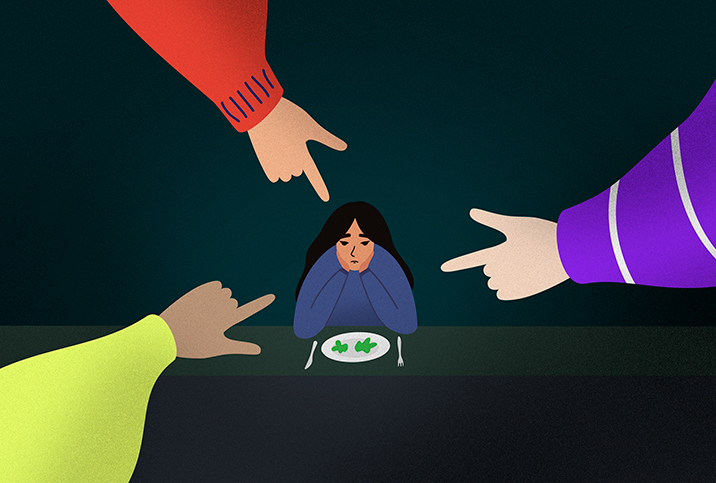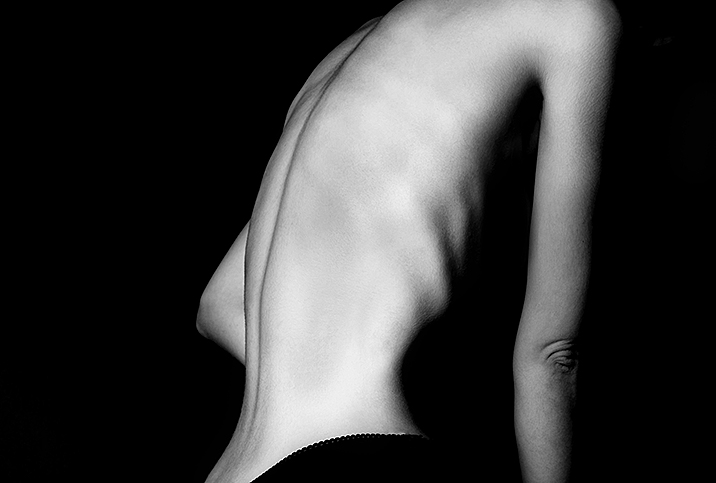'Skinny Was My Lifejacket': A Battle With Anorexia

I can't believe I'm grabbing a slice of pizza as I sit down to write this.
Flashback to age 12 or 13, when I threw tantrums to protest Mom taking me to after-church gatherings, which were always small and intimate. Everyone noticed when you didn't eat your allotted two slices—something that became a problem for me early on.
'It's not about the food'
Eating disorders—or, more broadly, disordered eating—fall along a spectrum. They adapt and change throughout time, and are about more than just a "silly" fear of being fat.
The Diagnostic and Statistical Manual of Mental Disorders 5—which as a now-graduate student in psychology, I open like the morning paper—is a big book used to diagnose psychiatric illnesses. It places "feeding and eating disorders" into eight categories, a strategy that carries its pros and cons. Having names for these things can be both clarifying and stifling.
The most well-known disorders are likely the big three: anorexia nervosa, bulimia nervosa and binge-eating disorder. Though disordered eating is their common denominator, Zach Verwey, a therapist based in Denver encouraged pause.
"There's always that need to identify that it's about the food, but that it's not about the food," Verwey said.
What I developed, which might fall under a subtype of anorexia (binge-purge type), was never officially diagnosed. I proclaim this loudly because I know many cases never will be. Looking at the diagnostic criteria, it's hard to believe only 9 percent of the world population has fallen prey to satisfying it:
- Self-evaluation is unduly influenced by body shape and weight (criterion D of bulimia nervosa)
- Intense fear of gaining weight or of becoming fat (criterion B of anorexia nervosa)
- Disturbance in the way in which one's body weight or shape is experienced (criterion C of anorexia nervosa)
"What a lot of people don't realize is that eating disorders are lifejackets," Verwey said. "They're something that has kept that person alive."
The bullying started early
At the risk of sounding trite, I often say disordered eating imprinted itself on me from a young age. After all, getting skinny was a way to elude bullying, after being the always-big girl, the always-tallest but also the always-widest. I was always positioned to stand in the back row of class photos. Never "blessed" by the body necessary to infiltrate the crisscross applesauce elite, smiling and donning the floor.
Around age 6 or 7, this relative hugeness started to wear on me. Not because of the actual weight, but the comparisons; it didn't seem to wear on anyone else. Among other girls, I felt like the "Ghostbusters" marshmallow man. Being so pale, practically translucent, helped cement the simile.
They knew it, too—knew they could use me to their advantage. Knew my body made them better than me, and that I was a safe "other" for whom they could define and pride themselves against.
During recess, they didn't let me join their games of freeze tag because I ran too slowly. Once, a classmate called me up to come over for a playdate but never came. Turns out her babysitter had dialed the wrong "Sarah" from the class list. The one she meant to call was the Sara without an "h," who not coincidentally was also the Sara without hips.
Fashion designer Nikki Lund reveals that her battle with anorexia began as a way to cope with high school bullies. Watch the full interview here.
Then there were the boys. Gabriel was my first crush—I felt bad for him. I felt bad that this quirky little blond kid, who wore glasses like me, also bore the misfortune of my desire for affirmation. Later, in third grade, that desire bloomed for Sam. Rose-colored glasses and flower petal feelings whenever we sat next to each other on the rug. I think I told him I liked him through a class game of telephone. The look he gave back, pity twisting into scornful laughter, was enough to make me stop liking boys with freckles.
During all this, I wasn't "fat," but rather "pudgy," "puffy," "plump." Maybe these words laid the groundwork for my aversion to the letter P. Especially names with P, like Pam.
Still, in other aspects of life, I had a lot to be grateful for. I had a stable home life, even if Dad was absent. I had friends, although they sometimes left to hang with the cool kids. And, importantly, I had a consistently stocked fridge.
I found a lot of joy through food, hobbies, music, movies and games, but never really felt part of a larger picture. Everyone else seemed to have it easy: They knew how to make friends and laugh and play sports and stop eating when they were full, and just be in their bodies.
Maybe I had resigned to my social status and started to disdain others who didn't seem to struggle like me. I learned to live with an inferiority complex, which protects itself with a façade of superiority, by age 10.
Skinny = pretty
It was this shaky superiority that carried me through, especially when the world started to undergird it. In the summer between seventh and eighth grades nature worked its wonders. Growth spurt. Slimmed-down. In the elevator, a neighbor remarked, "It looks as though someone just took you and stretched you thin, like a rubber band!"
Here was where popular girls started to pass me notes in class. Maybe we could be friends, they scribbled. Boys also began nodding and beaming their eyes up at me, with half-open lips, as if readying themselves to confess. Being pubescent boys, whatever they were turning over in their heads often exploded into laughter. But their laughs were different now. Now, I could make them jiggle and twitch not by being pathetic, but by making them nervous. At the end of middle school, Sammy, who sat next to me in math class and didn't have freckles, signed my yearbook with "yo, good looks kid."
From there on, and only increasing as the years went by, I received unrivalled attention from all sides: During morning commutes to school on the subway, through hundreds of likes of a Facebook profile photo, in little gazes, in crushes, in roses, in first boyfriends.
Getting skinny was a way to elude bullying, after being the always-big girl, the always-tallest but also the always-widest.
I never put a lot of effort into makeup, clothes or hair. But I did put the time and work into my body. My mantra was: skinny = pretty, skinny = safe, skinny = desirable.
Skinny was my lifejacket. With it, I could count on floating over the world. Even better, I could make it make me float, and the fact that this was all my doing, through restrictive eating and over-exercising and pizza-avoiding, made me better than the girls who were naturally thin. I was exempt from, yet above, the folly of eating like a regular person, and therefore everyone else.
This would be the lifejacket I would have to deflate before it squashed my rib cage. This would be the lifesaver swollen with pus that I would have to let other people help me puncture and flatten, with love.
More than a social sickness
Maybe this isn't a typical story about having an eating disorder. After all, I don't talk about the calculated calories, the elliptical hours, the thwarted social invitations and relationships as a proxy for self-love. Those details are nothing but an entire jar of marshmallow fluff polished off at 2 a.m. while sitting criss-cross on a kitchen floor.
"Unless you've really healed the root issue, and you've looked at the self-esteem and the shame and all of those underlying factors, it's still going to be there," Verwey said.
Part of my personal deflating process was recognizing that this sickness doesn’t only happen to me. This happens to all types of bodies: Black bodies, white bodies, Brown bodies, large bodies and small bodies. Bodies with and without ovaries. Some bodies with so many intersecting identities that they have to cling to their life jackets much tighter than I ever did.
Disordered eating is a social sickness, but it's a spiritual and political sickness, too. The girls and boys who bullied me were only acting out the scripts they were fed, every one of their cackling vomits revealing them a bit sicker.
I went on to memorialize their laughter through my own, redirected toward others who, at one time, I needed to believe I was better than.


















